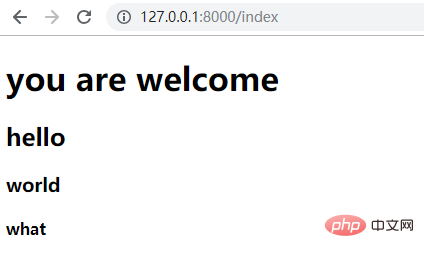Django使用locals() 函数的方法介绍
本篇文章给大家带来的内容是关于Django使用locals() 函数的方法介绍,有一定的参考价值,有需要的朋友可以参考一下,希望对你有所帮助。
locals() 函数会以字典类型返回当前位置的全部局部变量。
在 views.py 中添加
from django.shortcuts import render,HttpResponse,render_to_response
import datetime
from blog import models
def index(req):
if req.method=="POST":
username = req.POST.get("username")
pwd = req.POST.get("password")
print(username)
print(pwd)
if username == "klvchen" and pwd=="123":
return HttpResponse("登录成功")
#return render(req, "login.html")
kl = "you are welcome"
a = "hello"
b = "world"
c = "what"
return render_to_response("new.html", locals())在 templates 添加 new.html
<!DOCTYPE html>
<html lang="en">
<head>
<meta charset="UTF-8">
<title>Title</title>
</head>
<body>
<h1> {{ kl }}</h1>
<h2> {{ a }}</h2>
<h3> {{ b }}</h3>
<h4> {{ c }}</h4>
</body>
</html>在 urls.py 中 记得添加路径
url(r"index", views.index),
效果:
以上是Django使用locals() 函数的方法介绍的详细内容。更多信息请关注PHP中文网其他相关文章!

热AI工具

Undresser.AI Undress
人工智能驱动的应用程序,用于创建逼真的裸体照片

AI Clothes Remover
用于从照片中去除衣服的在线人工智能工具。

Undress AI Tool
免费脱衣服图片

Clothoff.io
AI脱衣机

Video Face Swap
使用我们完全免费的人工智能换脸工具轻松在任何视频中换脸!

热门文章

热工具

记事本++7.3.1
好用且免费的代码编辑器

SublimeText3汉化版
中文版,非常好用

禅工作室 13.0.1
功能强大的PHP集成开发环境

Dreamweaver CS6
视觉化网页开发工具

SublimeText3 Mac版
神级代码编辑软件(SublimeText3)
 怎么看django版本
Dec 01, 2023 pm 02:25 PM
怎么看django版本
Dec 01, 2023 pm 02:25 PM
查看django版本步骤:1、打开终端或命令提示符窗口;2、确保已经安装了Django,如果没有安装Django,可以使用包管理工具来进行安装,输入pip install django命令即可;3、安装完成后,可以使用python -m django --version来查看Django的版本。
 Django vs. Flask:Python Web框架的对比分析
Jan 19, 2024 am 08:36 AM
Django vs. Flask:Python Web框架的对比分析
Jan 19, 2024 am 08:36 AM
Django和Flask都是PythonWeb框架中的佼佼者,它们都有着自己的优点和适用场景。本文将对这两个框架进行对比分析,并提供具体的代码示例。开发简介Django是一个全功能的Web框架,它的主要目的是为了快速开发复杂的Web应用。Django提供了许多内置的功能,比如ORM(对象关系映射)、表单、认证、管理后台等。这些功能使得Django在处理大型
 Django框架的优点和缺点:您需要知道的一切
Jan 19, 2024 am 09:09 AM
Django框架的优点和缺点:您需要知道的一切
Jan 19, 2024 am 09:09 AM
Django是一个完整的开发框架,该框架涵盖了Web开发生命周期的各个方面。目前,这个框架是全球范围内最流行的Web框架之一。如果你打算使用Django来构建自己的Web应用程序,那么你需要了解Django框架的优点和缺点。以下是您需要知道的一切,包括具体代码示例。Django优点:1.快速开发-Djang可以快速开发Web应用程序。它提供了丰富的库和内
 如何升级Django版本:步骤和注意事项
Jan 19, 2024 am 10:16 AM
如何升级Django版本:步骤和注意事项
Jan 19, 2024 am 10:16 AM
如何升级Django版本:步骤和注意事项,需要具体代码示例引言:Django是一个功能强大的PythonWeb框架,它持续地进行更新和升级,以提供更好的性能和更多的功能。然而,对于使用较旧版本Django的开发者来说,升级Django可能会面临一些挑战。本文将介绍如何升级Django版本的步骤和注意事项,并提供具体的代码示例。一、备份项目文件在升级Djan
 django版本区别是什么
Nov 20, 2023 pm 04:33 PM
django版本区别是什么
Nov 20, 2023 pm 04:33 PM
区别是:1、Django 1.x系列:这是Django的早期版本,包括1.0、1.1、1.2、1.3、1.4、1.5、1.6、1.7、1.8和1.9等版本。这些版本主要提供基本的Web开发功能;2、Django 2.x系列:这是Django的中期版本,包括2.0、2.1、2.2等版本;3、Django 3.x系列:这是Django的最新版本系列,包括3.0、3等版本。
 怎么查看django版本
Nov 30, 2023 pm 03:08 PM
怎么查看django版本
Nov 30, 2023 pm 03:08 PM
查看django版本的方法:1、通过命令行查看,在终端或命令行窗口中输入“python -m django --version”命令;2、在Python交互式环境中查看,输入“import django print(django.get_version())”代码;3、检查Django项目的设置文件,找到名为INSTALLED_APPS的列表,其中包含已安装的应用程序信息。
 django是前端还是后端
Nov 21, 2023 pm 02:36 PM
django是前端还是后端
Nov 21, 2023 pm 02:36 PM
django是后端。详细介绍:尽管Django主要是一个后端框架,但它与前端开发密切相关。通过Django的模板引擎、静态文件管理和RESTful API等功能,前端开发人员可以与后端开发人员协作,共同构建功能强大、可扩展的Web应用程序。
 Django、Flask和FastAPI:哪个框架适合初学者?
Sep 27, 2023 pm 09:06 PM
Django、Flask和FastAPI:哪个框架适合初学者?
Sep 27, 2023 pm 09:06 PM
Django、Flask和FastAPI:哪个框架适合初学者?引言:在Web应用开发领域,有许多优秀的Python框架可供选择。本文将重点介绍Django、Flask和FastAPI这三款最受欢迎的框架。我们将评估它们的特点,并讨论哪个框架最适合初学者使用。同时,我们还将提供一些具体的代码示例,以帮助初学者更好地理解这几个框架。一、Django:Django






